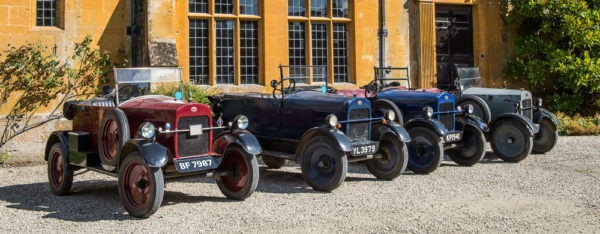
This lovely group of Trojans was seen outside Stanway House near the famous Prescott hillclimb. Definitely not as patrician as the venue, but historically equally important, the Trojan is a light car built from 1914. The company was founded by Leslie Hayward Hounsfield, a general engineer in a small workshop called the Polygon Engineering Works in Clapham, South London. He wanted to make a simple, economical car that would be easy to drive.
The prototype was completed in 1913. It had a two-stroke engine with four cylinders arranged in pairs, with each pair sharing a common combustion chamber. The pistons in each pair drove the crankshaft together as they were coupled to it by a V-shaped connecting rod. Each engine had only seven moving parts: four pistons, two connecting rods and a crankshaft. A two-speed epicyclic gearbox made for simple gear changing and final drive to the rear wheels was by chain. Solid tyres were used to prevent punctures – but very long springs gave sufficient comfort. There was no chassis: a punt-shaped tray carried the engine and transmission under the seats. The 1527cc engine was started by pulling a lever alongside the driver.
War intervened, and only in 1920 were the first cars made in Croydon. The final production version was shown at the 1922 London Motor Show. Leyland produced the cars at a spare facility in Kingston upon Thames until 1928, during which time 11,000 cars and 6700 vans were made.
The car cost £230 at launch and a highly competitive £125 in 1925 (the same as the Ford Model T). To prove how economical the car was to run, the company used the advertising slogan “Can you afford to walk?” – claiming that shoes and socks would cost more.
A major contract with Brooke Bond tea made their delivery vans a common sight throughout Britain.
Some attempts were made to replace the Trojan with a more modern car before the war, but Hounsfield had left the company in 1930 and the original design is still recognised as the classic Trojan.
Photo courtesy of Peter McFadyen. See his website: http://petermcfadyen.co.uk







Leave a Comment